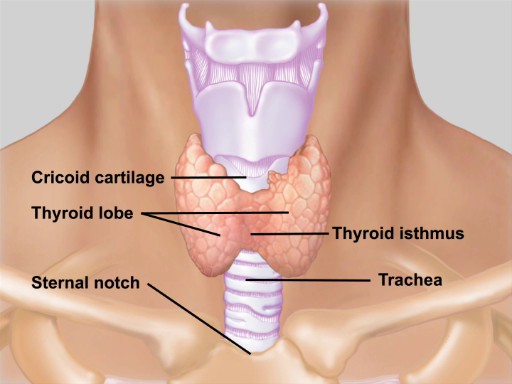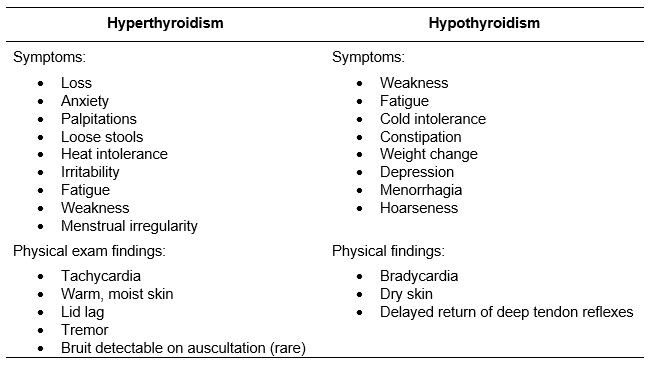갑상선 검사
English
소셜에 공유하기
개요
출처: 리처드 글릭먼-사이먼, MD, 조교수, 공중 보건 및 지역 사회 의학학과, 터프츠 의과 대학, 석사
갑상선은 크리시드 연골(위)과 상류층 노치(아래)(그림 1)사이의 목 전방 기관체에 위치하고 있다. 그것은 isthmus에 의해 연결된 오른쪽과 왼쪽 로브로 구성되어 있습니다. 이스머스는 두 번째, 세 번째, 네 번째 기관 고리를 커버하고, 로브는 기관및 식도의 측면을 뒤후방으로 곡선합니다. 10-25g의 일반 선은 일반적으로 검사에서 보이지 않으며 종종 눈에 띄지 않습니다. 가이터는 어떤 원인에서 확대 갑 상선입니다. 그 크기를 평가하는 것 외에도 모양, 이동성, 일관성 및 부드러움에 대해 갑상선을 만지는 것이 중요합니다. 정상적인 갑상선은 부드럽고 매끄럽고 대칭적이며 비부드럽으며 삼키면 약간 위로 미끄러집니다. 부드럽고 매끄러운 갑상선의 대칭 확대는 요오드 결핍 또는 두 가지 널리 퍼진 자가 면역 질환 중 하나인 그레이브스 병 또는 하시모토갑염으로 인한 발병 저갑상선증을 시사합니다. 갑상선 딱두얼은 일반적이고 일반적으로 부수적입니다; 그러나 갑상선 목절의 10%는 악성으로 판명되었습니다. 그들은 단일 또는 여러 수 있습니다., 그리고 가장 자주 확고 하 고 비 부드러운. 부드럽고 대칭적인 가이터는 일반적으로 갑상선염을 나타냅니다.

그림 1. 갑상선의 해부학. 목 구조에 대하여 갑상선의 위치 및 해부학의 삽화.
갑상선 질환은 거의 고립에서 만져 볼 수있는 고이터로 명시되지 않습니다. 갑 상선 호르몬 은 몸 전체에 걸쳐 세포 대사를 자극 하 여 주로 항상성을 유지 하는 역할을. 따라서, 갑상선 기능항진증은 증상및 신체적 발견의 범위와 연관된다(표 1). 갑상선 (정상적인 갑상선 호르몬 수준), 갑상선 또는 갑상선 일 수 있다는 점에 유의하는 것이 중요합니다. 두통 또는 시각 장애는 뇌 하 수 체 선 종으로 인해 이차 갑 상선 장애를 제안할 수 있습니다.

표 1. Hypo-and hyper-갑상선에 대 한 증상 및 물리적 결과.
Procedure
Applications and Summary
An enlarged thyroid gland, or goiter, is most often associated with normal thyroid gland function (euthyroid), but may be associated with hyper- or hypothyroid conditions. Therefore, thyroid abnormality found on physical examination should prompt a careful evaluation for the systemic signs and symptoms associated with both high and low thyroid hormone levels. A normal thyroid can be difficult to palpate, particularly in patients with large necks. However, its location can be precisely determined by identifying the bony and cartilaginous landmarks nearby: the cricoid cartilage above and the suprasternal notch below. In addition to an increase in size, the gland may show asymmetry, nodularity, or tenderness. Symmetrical goiters and thyroid nodules are not uncommon, and their detection should always prompt further investigation.
내레이션 대본
The thyroid physical examination is helpful for a clinician as it aids in narrowing down the differential diagnoses related to its anatomical pathology. The thyroid gland produces the thyroid hormones, which serve to maintain homeostasis throughout the body, primarily by stimulating cellular metabolism. Knowledge of the thyroid gland’s location and function is essential for diagnosing the commonly encountered pathologies, which are associated with its malfunctioning. The assessment of this gland should proceed in a systematic fashion, and this video will show the steps of this physical examination in detail.
The first step in examining the thyroid is to correctly locate it and understand its function, so before demonstrating the steps, let’s briefly review thyroid anatomy and physiology.
The thyroid gland is located in the neck, anterior to the trachea between the cricoid cartilage and the suprasternal notch. It consists of a right and left lobe connected by an isthmus. The isthmus covers the second, third, and fourth tracheal rings, and the lobes curve posteriorly around the sides of the trachea and esophagus.
The normal gland weighs 10-25 g, and is usually invisible on inspection and often difficult to palpate. Conversely, a goiter, which is an enlarged thyroid, is visible and palpable. In addition to assessing the goiter’s size, one must also palpate it for its shape, mobility, consistency, and tenderness. A normal thyroid is soft, smooth, symmetrical, and non-tender, and it slides upward slightly when swallowing. Symmetrical enlargement of a soft, smooth thyroid suggests endemic hypothyroidism due to iodine deficiency or one of two autoimmune disorders: Grave’s disease or Hashimoto’s thyroiditis Thyroid tenderness may be associated with the latter two conditions.
It should be noted that a goiter might be euthyroid, which indicates normal thyroid hormone levels, hyperthyroid, or hypothyroid. However, hyperthyroidism or hypothyroidism rarely manifests as a palpable goiter in isolation. Therefore, diagnosing thyroid disease requires a detailed understanding of the symptoms and physical exam findings associated with these conditions.
Other than goiter, thyroid nodules may also be palpable. These are common and usually incidental. However, 10% turn out to be malignant. They may be single or multiple, and are most often firm and non-tender.
Now that you have an idea of the structure and function of the thyroid gland, let’s go over the sequence of inspection and palpation steps for a thorough evaluation of this vital organ. Before the exam, thoroughly sanitize your hands using a disinfecting solution in view of the patient. Briefly explain the procedure you will perform.
Begin with inspection. Ask the patient to tip their head slightly back, and carefully inspect the anterior neck. If visible, the thyroid appears between the cricoid cartilage, which lies just beneath the protuberance of the thyroid cartilage also known as the Adam’s apple, and the suprasternal notch marked by the midline depression where the upper end of the sternum and clavicles meet. Check for symmetry, diffuse swelling, and obvious masses.
Offer the patient a cup of water and request to take a sip and swallow. Observe as the cricoid cartilage, thyroid cartilage, and thyroid gland move up and down. Next, proceed to palpation. Traditionally, this is done while standing behind the patient. Reach around with both hands and use your fingers to identify the landmarks from top to bottom. Start by feeling the mobile hyoid bone just beneath the mandible. Moving downwards, feel the thyroid cartilage with its superior notch, followed by the cricoid cartilage. Further down, you will feel the tracheal rings, and lastly the suprasternal notch.
After identifying the landmarks, place your index fingers just below the cricoid cartilage. Ask the patient to take another sip of water and swallow as before, and feel for the thyroid isthmus rising up under your finger pads. The isthmus is not always palpable, but if it is, feel for size, shape, and consistency. Also note any nodularity or tenderness. Lastly, palpate the thyroid lobes. Using the fingers of your right hand, gently move the trachea to the left and feel for the right lobe in the space between the trachea and sternomastoid muscle. Similarly examine the left lobe. If a goiter is detected, listen for a bruit by placing the stethoscope over the lateral lobes. If a bruit is present, it most likely indicates hyperthyroidism.
You’ve just watched JoVE’s demonstration of a comprehensive thyroid examination. You should now understand the anatomical location of the thyroid, how a goiter presents itself, what to look for during inspection, and finally the landmarks that help in thyroid palpation.
Remember, goiters and nodules are not uncommon. However, their detection should always prompt further investigation for the systemic signs and symptoms associated with hyper- and hypothyroidism. As always, thanks for watching!
